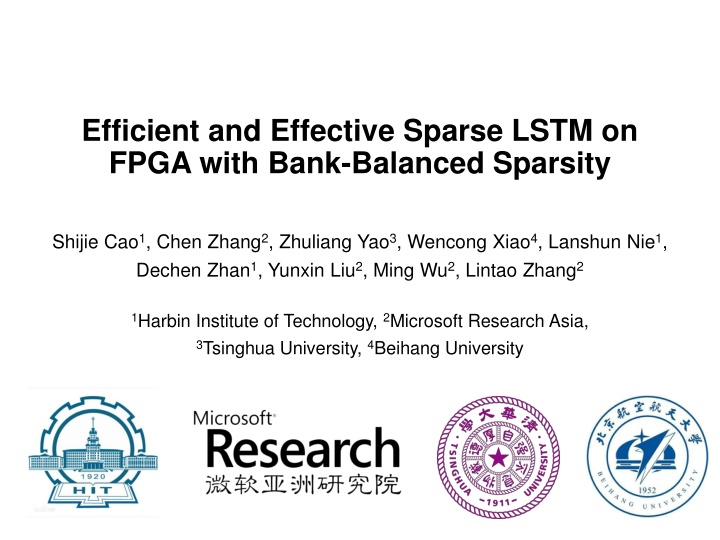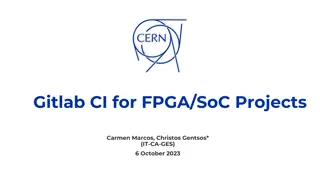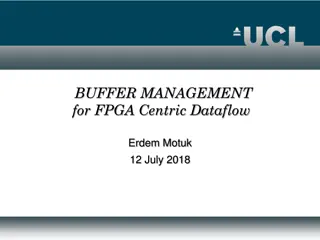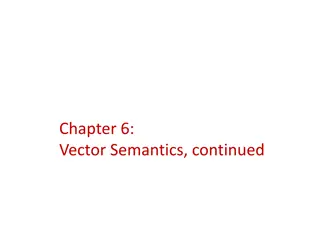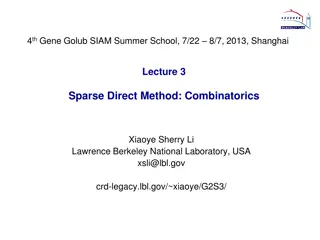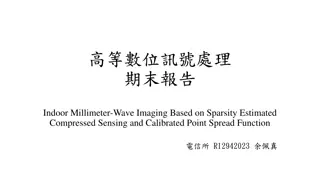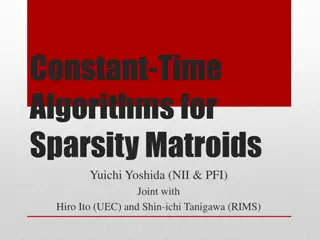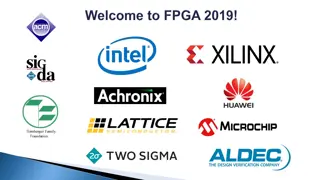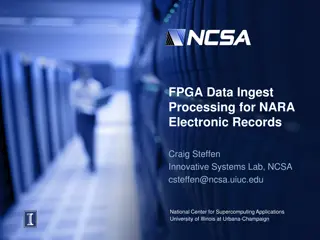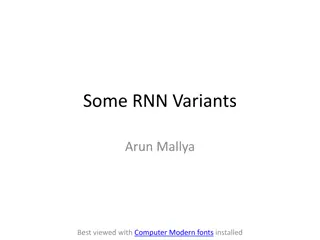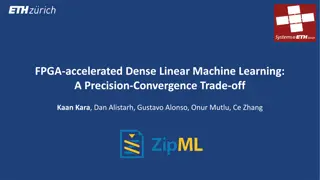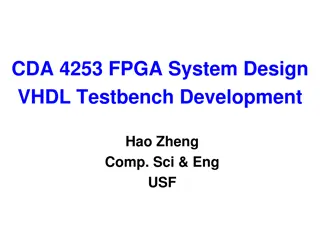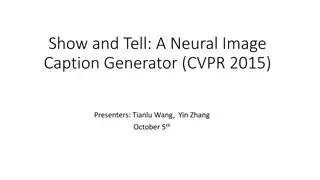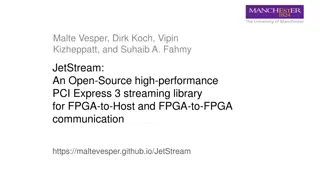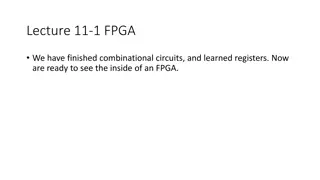Efficient and Effective Sparse LSTM on FPGA with Bank-Balanced Sparsity
Utilizing Bank-Balanced Sparsity, this work presents an efficient Sparse LSTM implementation on FPGA for real-time inference in various applications like machine translation, speech recognition, and synthesis. Through innovative design and evaluation, the model achieves high accuracy while maintaining hardware efficiency and low latency. The research addresses the challenge of growing model sizes for improved accuracy by focusing on low-latency inference of large LSTM models without batching. Additionally, weight pruning techniques are explored for learning both weights and connections in neural networks for enhanced efficiency.
Download Presentation

Please find below an Image/Link to download the presentation.
The content on the website is provided AS IS for your information and personal use only. It may not be sold, licensed, or shared on other websites without obtaining consent from the author.If you encounter any issues during the download, it is possible that the publisher has removed the file from their server.
You are allowed to download the files provided on this website for personal or commercial use, subject to the condition that they are used lawfully. All files are the property of their respective owners.
The content on the website is provided AS IS for your information and personal use only. It may not be sold, licensed, or shared on other websites without obtaining consent from the author.
E N D
Presentation Transcript
Efficient and Effective Sparse LSTM on FPGA with Bank-Balanced Sparsity Shijie Cao1, Chen Zhang2, Zhuliang Yao3, Wencong Xiao4, Lanshun Nie1, Dechen Zhan1, Yunxin Liu2, Ming Wu2, Lintao Zhang2 1Harbin Institute of Technology, 2Microsoft Research Asia, 3Tsinghua University, 4Beihang University
Outline Motivation Design Bank-Balanced Sparsity Pattern (BBS) Sparse Matrix Computation and Format for BBS BBS FPGA Accelerator Evaluation Model Accuracy Hardware Efficiency Conclusion
Outline Motivation Design Bank-Balanced Sparsity Pattern (BBS) Sparse Matrix Computation and Format for BBS BBS FPGA Accelerator Evaluation Model Accuracy Hardware Efficiency Conclusion
Real-time Inference of LSTM Machine Translation Speech Recognition Speech Synthesis
Real-time Inference of LSTM Machine Translation Speech Recognition Speech Synthesis User-interactive and latency-sensitive applications
Real-time Inference of LSTM Machine Translation Speech Recognition Speech Synthesis User-interactive and latency-sensitive applications Model size continues to grow to achieve higher accuracy
Real-time Inference of LSTM Machine Translation Speech Recognition Speech Synthesis User-interactive and latency-sensitive applications Model size continues to grow to achieve higher model accuracy Low latency inference of large LSTM model with no batching
Quick Intro to LSTM A popular type of RNN ?? ct 1: long-term information ct 1 ?? ?t ?? 1 The most computation-heavy part: Matrix-Vector Multiplication (MxV)
Weight Pruning Han, Song, et al. Learning both Weights and Connections for Efficient Neural Networks, NIPS 15
Weight Pruning Difficult to accelerate Prune away small weights Unstructured sparse matrices MxV SpMxV Han, Song, et al. Learning both Weights and Connections for Efficient Neural Networks, NIPS 15
Accuracy and Speedup Tradeoff Fine-grainedCoarse-grained IrregularRegular Pros: High model accuracy High compression ratio Cons: Irregular pattern Difficult to accelerate Cons: Low model accuracy Low compression ratio Pros: Regular pattern Easy to accelerate
How to Achieve Both? Model accuracy Add few constraints on the sparsity pattern Speedup Matrix partitioning for parallel computing Eliminating irregular computation and memory access
Outline Motivation Design Bank-Balanced Sparsity Pattern (BBS) Sparse Matrix Computation and Format for BBS BBS FPGA Accelerator Evaluation Model Accuracy Hardware Efficiency Conclusion
Outline Motivation Design Bank-Balanced Sparsity Pattern (BBS) Sparse Matrix Computation and Format for BBS BBS FPGA Accelerator Evaluation Model Accuracy Hardware Efficiency Conclusion
Bank-Balanced Pruning Bank Split Dense Matrix
Bank-Balanced Pruning Bank Split Dense Matrix Traverse all rows 0 1 2 3 4 5 6 7 8 9 10 11 12 13 14 15 Dense Matrix Row 0.8 -0.1 0.2 1.5 1.0 0.3 -0.4 -1.4 0.7 2.0 0.9 -0.5 1.2 -1.3 2.1 0.2 Fine-grained pruning inside each bank BBS Matrix Row 0.8 1.5 1.0 -1.4 2.0 0.9 -1.3 2.1 Threshold percentage to obtain identical sparsity ratio among banks
Bank-Balanced Sparsity (BBS) Bank partitioning for parallel computing Fine-grained pruning inside each bank for maintaining accuracy
Weight map visualization Visual comparison
Weight map visualization Visual comparison Bank 0 Bank 1
Weight map visualization Visual comparison Bank 0 Bank 1 Effect on model accuracy in evaluation results
Outline Motivation Design Bank-Balanced Sparsity Pattern (BBS) Sparse Matrix Computation and Format for BBS BBS FPGA Accelerator Evaluation Model Accuracy Hardware Efficiency Conclusion
Sparse MV Multiplication (SpMxV) Inter-row parallelism: multiple PEs Vector Matrix PE 0 PE 1 PE 2 PE 3 PE 4 PE 5
Sparse MV Multiplication (SpMxV) Intra-row (inter-bank) parallelism: Vector Matrix V0 V1 V2 V3 V4 V5 V6 V7 V8 V9 V10 V11 A 0 B C D 0 0 E F G 0 H PE 0 PE 1 PE 2 PE 3 PE 4 PE 5
Sparse MV Multiplication (SpMxV) Intra-row (inter-bank) parallelism: BSB matrix row Dense vector 0 B D 0 0 F 0 H A C E G V0 V1 V2 V3 V4 V5 V6 V7 V8 V9 V10 V11 Bank 0 Bank 1 Bank 2 Bank 3 A C E G
Sparse MV Multiplication (SpMxV) Intra-row (inter-bank) parallelism: BSB matrix row 0 B D 0 0 F 0 H A C E G Bank 0 Bank 1 Bank 2 Bank 3 Dense vector V0 V1 V2 A C E G Bank 0 V3 V4 V5 Bank 1 V6 V7 V8 Bank 2 V9 V10 V11 Bank 3
Sparse MV Multiplication (SpMxV) Intra-row (inter-bank) parallelism: BSB matrix row 0 B D 0 0 F 0 H A C E G Bank 0 Bank 1 Bank 2 Bank 3 Dense vector V0 V1 V2 A C E G V0 V3 V7 V9 Bank 0 V3 V4 V5 Partial dot product: V0 A+V3 C+V7 E+V9 G Bank 1 S1 V6 V7 V8 Accumulate Bank 2 V9 V10 V11 Bank 3
Sparse MV Multiplication (SpMxV) Intra-row (inter-bank) parallelism: BSB matrix row A 0 C 0 0 E G 0 B D F H Bank 0 Bank 1 Bank 2 Bank 3 Dense vector V0 V1 V2 B D F H V2 V4 V8 V11 Bank 0 V3 V4 V5 Partial dot product: V2 B+V4 D+V8 F+V11 H Bank 1 S2 V6 V7 V8 Accumulate Bank 2 V9 V10 V11 S1+S2 Bank 3
Sparse MV Multiplication (SpMxV) Both inter-row and inter-bank parallelism Load balancing across rows and banks Bank 3 Bank 2 Bank 0 Bank 1 A 0 B C D 0 0 E F G 0 H Row 0 I J 0 K 0 L M N 0 O P 0 Row 1 Dense vector V0 V1 V2 Bank 0 Conflict-free vector accesses V3 V4 V5 Bank 1 V6 V7 V8 Bank 2 V9 V10 V11 Bank 3
CSR (Compressed Sparse Rows) Decoding overhead in BBS Rearrange the order
CSR (Compressed Sparse Rows) Decoding overhead in BBS Rearrange the order Compute the index in bank
Our CSB (Compressed Sparse Banks) 0 A 0 1 C 0 2 E 0 3 G 1 4 B 2 5 D 2 6 F 3 7 H 2 8 I 0 9 K 0 10 11 12 13 14 15 M O J 1 3 1 CSB L 2 N 3 P 1 VALUES BANK INTERNAL INDICES Specifically designed for BBS to eliminate decoding overheads
Our CSB (Compressed Sparse Banks) Data rearrangement for inter-bank parallelization 0 A 0 1 C 0 2 E 0 3 G 1 4 B 2 5 D 2 6 F 3 7 H 2 8 I 0 9 K 0 10 11 12 13 14 15 M O J 1 3 1 CSB L 2 N 3 P 1 VALUES BANK INTERNAL INDICES Specifically designed for BBS to eliminate decoding overheads
Our CSB (Compressed Sparse Banks) 0 1 2 3 0 1 2 3 0 1 2 3 0 1 2 3 Data rearrangement for inter-bank parallelization 0 A 0 1 C 0 2 E 0 3 G 1 4 B 2 5 D 2 6 F 3 7 H 2 8 I 0 9 K 0 10 11 12 13 14 15 M O J 1 3 1 CSB L 2 N 3 P 1 VALUES BANK INTERNAL INDICES Physical BRAM addresses Specifically designed for BBS to eliminate decoding overheads
Outline Motivation Design Bank-Balanced Sparsity Pattern (Pruning Method) Sparse Matrix Computation and Format for BBS BBS FPGA Accelerator Evaluation Model Accuracy Hardware Efficiency Conclusion
Accelerator Overview FPGA Controller Instruction Buffer Host Server PCIe Cntlr SpMxV PE EWOP **+ ACT + + Values Matrix Memory * + * * D M A Output Private Vector Buffer + ... Indices Off-chip DRAM DRAM Cntlr Vector Memory
Accelerator Overview FPGA Controller Instruction Buffer Host Server PCIe Cntlr SpMxV PE EWOP **+ ACT + + Values Matrix Memory * + * * D M A Output Private Vector Buffer + ... Indices Off-chip DRAM DRAM Cntlr Vector Memory
Accelerator Overview FPGA Controller Instruction Buffer Host Server PCIe Cntlr SpMxV PE EWOP **+ ACT + + Values Matrix Memory * + * * D M A Output Private Vector Buffer + ... Indices Off-chip DRAM DRAM Cntlr Vector Memory
Accelerator Overview FPGA Controller Instruction Buffer Host Server PCIe Cntlr SpMxV PE EWOP **+ ACT + + Values Matrix Memory * + * * D M A Output Private Vector Buffer + ... Indices Off-chip DRAM DRAM Cntlr Vector Memory
Outline Motivation Design Bank-Balanced Sparsity Pattern (BBS) Sparse Matrix Computation and Format for BBS BBS FPGA Accelerator Evaluation Model Accuracy Hardware Efficiency Conclusion
Model Accuracy Language model PTB dataset Speech Recognition on TIMIT dataset
Model Accuracy Very close Language model PTB dataset Speech Recognition on TIMIT dataset
Model Accuracy Very close Language model PTB dataset Speech Recognition on TIMIT dataset
Sensitivity to Bank Size LSTM model on PTB dataset Comparisons Different bank size in BBS Different block size in Block sparsity Accuracy drop Almost the same
Hardware Efficiency FPGA platform Catapult[1] with Intel Arria 10 Architecture setting M = 64 (64 PEs in the SpMxV unit) N = 64 (each PE has 64 multipliers) 16-bit data precision Model and Dataset LSTM on TIMIT dataset [1] Caulfield, Adrian M., et al. A loud-Scale Acceleration Architecture, MICRO 16.
Hardware Efficiency FPGA platform Catapult[1] with Intel Arria 10 Architecture setting M = 64 (64 PEs in the SpMxV unit) N = 64 (each PE has 64 multipliers) 16-bit data precision Model and Dataset LSTM on TIMIT dataset Comparisons ESE[2] : improves throughput through batching C-LSTM[3] : block-circulant matrices Delta-RNN[4] : skip dispensable neuron activations [1] Caulfield, Adrian M., et al. A loud-Scale Acceleration Architecture, MICRO 16. [2] Han, Song, et al. ESE: Efficient Speech Recognition Engine with Sparse LSTM on FPGA, FPGA 17 [3] Gao, Chang, et al. DeltaRNN: A Power-Efficient Recurrent Neural Network Accelerator, FPGA 18. [4] Wang, Shuo, et al. C-LSTM: Enabling Efficient LSTM using Structured Compression Techniques on FPGAs, FPGA 18.
Hardware Efficiency ~34x ~7x
Hardware Efficiency Much better single batch performance because Enabling extra inter-bank parallelism Addressing the irregular memory access in SpMxV
